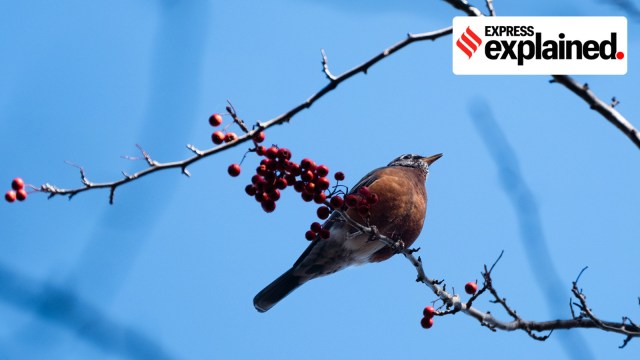Why some birds flock to wealthier neighbourhoods: Links to civic design, inequality and more
Recent studies have illustrated the links between structural racism, pernicious landscape features such as urban heat islands, and its impacts to biodiversity – including the birds you might spot in your city.
 An American robin in East End Park in Durham, N.C., Nov. 2, 2023. As a discipline, urban ecology is only about a quarter-century old. (Cornell Watson/The New York Times)
An American robin in East End Park in Durham, N.C., Nov. 2, 2023. As a discipline, urban ecology is only about a quarter-century old. (Cornell Watson/The New York Times)Written by Hillary Rosner
At a meeting of urban wildlife researchers in Washington, D.C., in June, one diagram made it into so many PowerPoint presentations that its recurrence became a running joke. The subject, though, was serious: The diagram, which came from a study published in the fall of 2020 in the journal Science, illustrated the links between structural racism, pernicious landscape features such as urban heat islands, and impacts to biodiversity.
The study, “Ecological and Evolutionary Consequences of Systemic Racism in Urban Environments,” was led by Christopher Schell, an ecologist at the University of California, Berkeley, and it synthesized what a handful of urban ecologists around the country had begun demonstrating: that patterns of bigotry and inequality affect how other species experience life in cities.
Schell, who is Black and from Los Angeles, said he grew up with an understanding that “there is a ton of heterogeneity that exists in a city, and it’s not by accident that it’s that way.” Those variations could include the numbers of parks and street trees in different neighborhoods, whether a highway or rail line ripped through a community, or whether an oil refinery spewed toxic emissions into the air.
 Signage in a formerly redlined neighborhood in Los Angeles, Nov. 3, 2023. Eric Wood and his colleagues found that predominantly Hispanic neighborhoods that were previously redlined had fewer forest birds such as warblers, wrens and bluebirds. (Tracy Nguyen/The New York Times)
Signage in a formerly redlined neighborhood in Los Angeles, Nov. 3, 2023. Eric Wood and his colleagues found that predominantly Hispanic neighborhoods that were previously redlined had fewer forest birds such as warblers, wrens and bluebirds. (Tracy Nguyen/The New York Times)
As a discipline, urban ecology is only about a quarter-century old, and until very recently, its practitioners tended to treat cities mainly as a contrast to rural areas, without considering the wild disparities among and within cities.
Schell wanted to show that urban heterogeneity, in turn, “is driven by systemic inequities,” he said, such as “oppression, residential segregation, gentrification and displacement, unjust zoning laws, homelessness, so on, so on, so on.” Those issues don’t impact only people, he added: “How we operate influences the rest of the natural world as well as the social world.”
Over the past few years, a widening group of urban ecologists has been fanning out to study the overlap between environmental justice and biodiversity conservation, fields that had previously tended to keep to their own corners. Schell said that, in his lab, researchers “oftentimes do our own version of ‘six degrees of separation from Kevin Bacon’” to show how human actions ripple out to wildlife.
“Air pollution isn’t just restricted to people,” he said. “Other animals have lungs. Why would we not expect them to also be inhaling the same amount of pollutants that we generate?”
Madhusudan Katti, an ecologist at North Carolina State University who has worked at the intersection of biodiversity conservation and human well-being for most of his career, agreed.
“Often the interests of other species and marginalized humans align,” he said. “It’s very much a colonial perspective to think about humans and wildlife as separate. We need to start thinking about humans and wildlife together in the landscape and mitigate things that will help both.”
Ecological Fingerprints
This growth of urban ecology has been aided, in part, by Mapping Inequality, a sprawling, multiuniversity project from the University of Richmond’s Digital Scholarship Lab. It created a digital archive of “redlining,” the New Deal-era housing policy that enforced and perpetuated neighborhood segregation in the United States.
In 1933, the federal government created the Home Owners Loan Corporation, or HOLC, whose intent was to help Americans recover from the Depression. HOLC issued accessible home loans or refinanced mortgages to prevent default. To do this, it mapped more than 200 U.S. cities based on the perceived risk of lending money in various areas, grading neighborhoods from A to D and outlining them in corresponding colors, from green to red.
Grades were based on the condition of the housing stock and on the race, ethnicity and income of residents. Neighborhoods with newer homes and more U.S.-born, white residents were usually graded A and outlined in green. Those with older homes and more immigrants and people of color were generally graded D and outlined in red. The redlined neighborhoods were deemed “hazardous” to invest in.
Ninety years later, nearly three-fourths of the redlined neighborhoods are still struggling financially and nearly two-thirds are “majority minority,” according to a study from 2018. The human legacy of redlining is vast: poverty, unemployment, health problems, decades of lost wealth and opportunities.
The policy also left ecological fingerprints on many cities, effects that urban ecologists are now eagerly bringing to light. “There are just more people who have hardcore wildlife training who are starting to look at cities as a place to do their work,” said Eric Wood, an ornithologist and urban ecologist with California State University in Los Angeles and the Natural History Museum of Los Angeles County. “If you’d told me as a Ph.D. student, ‘Go study birds in LA,’ I’d have said: ‘No way. I’m going to Borneo.’”
When Wood first moved to Los Angeles in 2015, he was keen to apply his field skills in a big city.
“I’m a birder and a natural history person, and for 25 years, I’d gone out and identified all the birds and plants and insects,” he said.
He planned to do the same thing in Los Angeles. To measure biological diversity in a given landscape, an ecologist needs to capture the range of environmental variability there — the heterogeneity. In a natural setting, that might mean looking at different elevations, hills that face north versus south, or areas with wetter or drier soil. In Los Angeles, Wood soon found, the environmental variability was also based on neighborhoods’ socioeconomic status.
He and others recently surveyed birds across the sprawling metropolis and analyzed the findings against redlining maps. They found that predominantly white neighborhoods, which were often the ones “greenlined” on the HOLC maps, hosted a greater abundance of birds that generally live in forests, such as warblers, wrens and bluebirds.
In contrast, areas that today are predominantly Hispanic and were previously redlined have fewer of those forest birds and more “synanthropic” species, those often found in dense urban areas. (These include pigeons and sparrows but also crows and ravens, mourning doves, house finches and even a type of hummingbird.) In an article last month in the journal Ornithological Applications, the researchers wrote that the distribution of birds in the greater Los Angeles area today reflected “patterns of income inequality, both past and present, that carry over to influence urban biodiversity.”
Another study, published in 2022, used publicly available genetic data from nearly 7,700 individual animals belonging to 39 species of vertebrates. It found that across 268 urban locations in the United States, the wildlife in neighborhoods with greater proportions of white residents had higher levels of genetic diversity and more evidence of connected populations of animals, which interbreed and exchange DNA. Genetic diversity is essential for wildlife populations to weather a catastrophe such as a pandemic or a wildfire.
The finding revealed a blunt truth: Like a wall or a highway, systemic racism creates a barrier to wildlife movement. “The whole process changes your view of the world, honestly,” Chloé Schmidt, the paper’s lead author and a senior scientist at the German Center for Integrative Biodiversity Research, said of the study.
Schmidt, who is of mixed race, said that when she was growing up in New Jersey, her parents sometimes mentioned that the original deed to their house “said Black people couldn’t live there.” For her doctoral research, she had been assembling a database of genetic information about biodiversity, and when she read Schell’s paper, she realized that she had the data to test his ideas.
“Redlining was so consistently practiced for so long in the U.S., we thought we could find a signal,” she said. Still, she was surprised by her own findings. “It was like, oh, God, how bad must this have been to still find a signal even when redlining was stopped in the ’60s,” she said.
This article originally appeared in The New York Times.



- 01
- 02
- 03
- 04
- 05



































